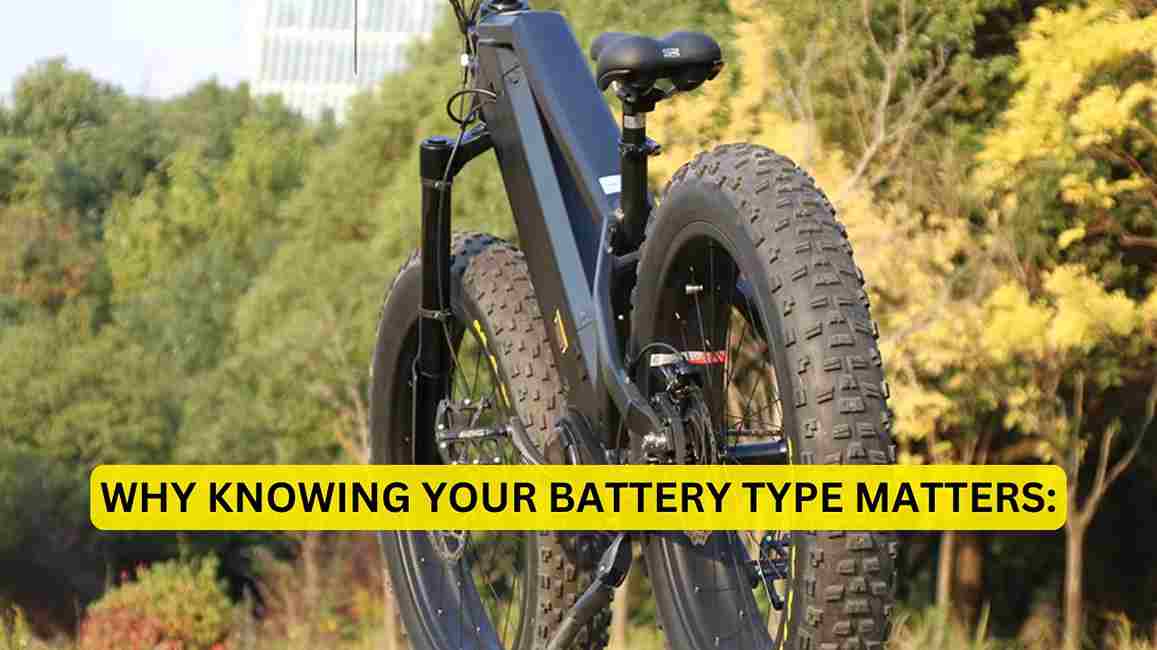Some Tips for Taking Care of Your Ebike Battery
E-bike batteries are the heart of your electric bike, powering every ride and impacting your overall biking experience. Just like any other essential component, a well-maintained battery can significantly extend its lifespan and ensure you get the most out of each charge. Proper care not only boosts the battery’s performance but also enhances your riding efficiency and safety.
In this post, we’ll share practical tips to help you keep your e-bike battery in top shape, ensuring smooth and reliable rides for years to come. Whether you’re a seasoned e-bike enthusiast or new to the electric biking world, these tips will help you maximize the life and effectiveness of your battery.
1. Understand Your Battery Type
Before diving into the specifics of battery care, it’s essential to understand the type of battery your e-bike uses. Different battery types have distinct characteristics and maintenance needs, so knowing your battery’s specifications will help you provide the best care.
- Lithium-ion Batteries: These are the most common in modern e-bikes due to their high energy density and long lifespan. They typically require specific charging practices and have a range of 500 to 1,000 charge cycles. Lithium-ion batteries are sensitive to extreme temperatures, so it’s important to avoid exposing them to high heat or freezing cold.
- Lead-acid Batteries: Older and less common in newer models, lead-acid batteries are heavier and have a shorter lifespan compared to lithium-ion. They are less expensive but require more frequent maintenance, such as ensuring they are fully charged and checking electrolyte levels.
- Nickel-Metal Hydride (NiMH) Batteries: These batteries are less common but still used in some e-bikes. They offer a balance between the energy density of lithium-ion and the cost-effectiveness of lead-acid. NiMH batteries should be maintained by keeping them in moderate temperatures and avoiding deep discharges.
- Solid-state Batteries: An emerging technology in e-bike batteries, solid-state batteries promise higher safety and energy density. Though not widely available yet, they will have specific care instructions once they become more common.
Why Knowing Your Battery Type Matters:

- Charging Requirements: Different battery types have unique charging needs. For instance, lithium-ion batteries should not be overcharged, while lead-acid batteries require regular topping off to maintain their performance.
- Storage Conditions: The optimal storage conditions vary; lithium-ion batteries should be kept in a cool, dry place, while lead-acid batteries might need a more controlled environment to prevent sulfation.
- Maintenance Routines: Each battery type requires a different approach to maintenance. Understanding these needs will help you avoid common pitfalls and extend the life of your battery.
By identifying and understanding your e-bike battery type, you can follow the appropriate care guidelines and ensure your battery remains in excellent condition for the long haul.
2. Regular Charging Practices
Proper charging is crucial for maintaining the health and longevity of your e-bike battery. Here are some key practices to follow:
- Avoid Complete Discharges: Try not to let your battery fully deplete before recharging. Most modern e-bike batteries are designed to handle partial discharges better than complete ones. Ideally, recharge your battery when it reaches about 20-30% charge.
- Use the Correct Charger: Always use the charger specifically designed for your e-bike battery. Using an incorrect charger can lead to improper charging rates and potentially damage the battery. Check your e-bike manufacturer’s recommendations for the right charger.
- Avoid Overcharging: Overcharging can reduce your battery’s lifespan. Modern chargers are designed to stop charging once the battery is full, but it’s still a good practice to unplug the charger once the battery is fully charged. Avoid leaving the battery connected to the charger for extended periods.
- Charge in Optimal Conditions: Charging in extreme temperatures can affect battery performance. Ideally, charge your battery in a cool, dry place. Avoid charging in very hot or very cold environments, as this can impact the battery’s efficiency and longevity.
- Charge After Rides: It’s a good habit to recharge your battery after each ride, even if it’s not fully depleted. This ensures you have a full charge for your next ride and reduces the risk of deep discharges.
- Avoid Frequent Rapid Charges: While quick charging can be convenient, frequent use of rapid chargers can heat up the battery and potentially shorten its lifespan. Use rapid charging only when necessary and rely on standard charging for regular maintenance.
- Monitor Charge Levels: Keep an eye on your battery’s charge levels through your e-bike’s display or an accompanying app. This will help you avoid running out of power unexpectedly and allow you to plan your rides and charging sessions more effectively.
By following these regular charging practices, you can help ensure that your e-bike battery remains in optimal condition, providing reliable performance and extending its useful life.
3. Storage Tips
Proper storage is vital for maintaining the health of your e-bike battery, whether you’re putting it away for a short period or preparing it for long-term storage. Here’s how to store your e-bike battery effectively:
- Keep It in a Cool, Dry Place: Store your battery in a location that’s free from extreme temperatures and high humidity. Ideal storage conditions are a cool, dry area away from direct sunlight and heat sources. Extreme temperatures can degrade the battery’s performance and lifespan.
- Avoid Freezing Temperatures: Cold temperatures can negatively impact your battery’s performance and lead to potential damage. If you live in a region with freezing temperatures, bring your battery indoors or store it in a temperature-controlled environment.
- Charge to 50% for Long-Term Storage: If you plan to store your battery for an extended period, aim to leave it with a charge level around 50%. This helps prevent the battery from becoming over-discharged, which can damage it. Avoid storing the battery in a fully charged or fully depleted state.
- Disconnect and Remove the Battery: If you’re storing your e-bike for a prolonged period, it’s a good idea to disconnect and remove the battery from the bike. This helps prevent any potential drain on the battery and reduces the risk of accidental damage.
- Check Battery Condition Regularly: Even during storage, it’s important to check your battery periodically. Look for signs of swelling, leakage, or any other irregularities. If you notice any issues, it may be time to seek professional advice or consider replacing the battery.
- Protect from Physical Damage: Ensure that the battery is stored in a safe location where it’s protected from physical damage or impacts. Avoid placing heavy objects on top of the battery or exposing it to potential sources of damage.
- Follow Manufacturer’s Guidelines: Always refer to the specific storage recommendations provided by your e-bike’s manufacturer. Different battery types and models may have unique storage requirements.
By following these storage tips, you can help ensure that your e-bike battery remains in good condition, ready for use when you need it, and performs optimally throughout its lifespan.
4. Cleaning and Maintenance
Keeping your e-bike battery clean and well-maintained is essential for its longevity and performance. Here are some key tips for proper cleaning and maintenance:

- Regular Inspections: Periodically inspect your battery for signs of damage or wear. Check for any visible issues such as cracks, corrosion, or loose connections. Addressing these issues early can prevent more significant problems.
- Cleaning the Battery:
- Surface Cleaning: Use a dry or slightly damp cloth to wipe the exterior of the battery. Avoid using harsh chemicals or abrasive materials that could damage the battery’s surface or connectors.
- Connector Cleaning: If the battery connectors or contacts appear dirty, use a soft brush or a cloth lightly dampened with rubbing alcohol to gently clean them. Ensure that the connectors are dry before reassembling or reconnecting the battery.
- Avoid Water Exposure: Keep the battery and its connectors away from water. Exposure to moisture can lead to electrical issues or corrosion. If the battery does get wet, dry it thoroughly before use or charging.
- Check and Tighten Connections: Regularly check the battery connections and cables for any signs of looseness or wear. Tighten any loose connections carefully, but avoid overtightening, which can damage the connectors.
- Monitor Battery Performance: Pay attention to how your battery performs during rides. A noticeable decrease in range or performance could indicate an issue with the battery. Keep track of these changes and consult a professional if problems persist.
- Address Battery Alerts: If your e-bike’s display or app provides alerts or warnings related to the battery, take them seriously. Follow the troubleshooting steps provided or seek professional assistance to address any issues.
- Store Battery Properly During Maintenance: If you need to remove the battery for cleaning or maintenance, store it in a safe and dry location while you work. This prevents accidental damage and ensures you have a clean workspace.
- Professional Servicing: For more in-depth maintenance or if you’re unsure about any aspect of battery care, seek help from a professional technician. They can perform more comprehensive checks and repairs as needed.
By following these cleaning and maintenance practices, you can help ensure that your e-bike battery stays in optimal condition, enhancing its performance and extending its lifespan.
5. Usage Guidelines
Proper usage of your e-bike and its battery can greatly influence its performance and longevity. Here are some guidelines to follow for optimal battery use:
- Manage Battery Power Wisely:
- Use the Power Assist Wisely: Utilize different power modes appropriately. For example, use lower power settings for flat terrain and reserve higher settings for steep inclines or challenging conditions. This helps in conserving battery life.
- Plan Your Rides: Estimate the range based on your battery’s charge level and plan your routes accordingly. Avoid pushing the battery to its limits, especially on longer rides.
- Avoid Excessive Strain:
- Smooth Riding: Try to ride smoothly and avoid sudden accelerations or high speeds that can put extra strain on the battery. Gradual acceleration and braking can help extend battery life.
- Regularly Check Tire Pressure: Properly inflated tires reduce rolling resistance and improve overall efficiency, which can help conserve battery power.
- Use Regenerative Braking (if available): Some e-bikes come with regenerative braking systems that help recharge the battery while braking. If your e-bike has this feature, use it to take advantage of the extra charge and extend your range.
- Avoid Overloading the Bike: Excess weight or carrying heavy loads can put additional strain on the battery. Keep your bike’s load within recommended limits to maintain efficiency and performance.
- Monitor Battery Temperature: Be mindful of how temperature affects battery performance. If you’re riding in very hot or very cold conditions, the battery may not perform optimally. If possible, avoid extreme temperatures to preserve battery health.
- Use the E-Bike Regularly: Regular use of your e-bike helps keep the battery active and in good condition. If you leave the battery unused for extended periods, it may deteriorate faster. Aim for regular rides to keep the battery in optimal working order.
- Follow Manufacturer Recommendations: Always refer to your e-bike manufacturer’s guidelines for usage. They provide specific recommendations for your model, including optimal usage practices and maintenance schedules.
By adhering to these usage guidelines, you can help ensure that your e-bike battery remains efficient and reliable, providing you with smooth and enjoyable rides.
6. Battery Health Monitoring
Regularly monitoring your e-bike battery’s health is crucial for ensuring optimal performance and longevity. Here’s how to effectively keep track of your battery’s condition:

- Use Built-in Diagnostics: Many e-bikes come with built-in diagnostic tools or displays that provide real-time information about your battery’s status. Pay attention to indicators such as charge level, voltage, and overall battery health.
- Leverage Mobile Apps: Some e-bikes are equipped with companion apps that allow you to monitor battery health and performance. These apps can provide detailed insights into charge cycles, battery capacity, and other important metrics. Check the app regularly to stay informed.
- Understand Battery Indicators: Learn how to interpret the battery indicators on your e-bike’s display. Common indicators include battery percentage, range estimate, and warning lights. Understanding these indicators helps you make informed decisions about charging and usage.
- Track Performance Trends: Keep a record of your battery’s performance over time. Note any changes in range, charge times, or performance issues. Tracking these trends can help you identify potential problems early and take appropriate action.
- Check for Warning Signs: Be alert for any warning signs that may indicate battery issues, such as reduced range, slow charging, unusual noises, or error messages. Address these signs promptly to avoid further complications.
- Perform Regular Battery Health Checks: Periodically check the battery’s condition by assessing its physical appearance and performance. Look for signs of swelling, leakage, or corrosion, and consult a professional if you notice any of these issues.
- Consult Manufacturer’s Guidelines: Refer to your e-bike manufacturer’s guidelines for specific recommendations on monitoring and maintaining battery health. Manufacturers often provide detailed information on how to assess and care for your battery.
- Seek Professional Advice: If you’re unsure about the health of your battery or if you encounter persistent issues, seek advice from a professional technician. They can perform more comprehensive diagnostics and provide solutions for any problems.
By actively monitoring your e-bike battery’s health, you can ensure it remains in good condition, providing reliable performance and extending its lifespan. Regular checks and prompt attention to issues will help you get the most out of your e-bike.
7. Troubleshooting Common Issues
Even with proper care, e-bike batteries can occasionally encounter problems. Here’s a guide to troubleshooting common battery issues:
-
Battery Not Charging
- Check the Charger: Ensure that the charger is correctly plugged in and functioning. Test it with another battery or e-bike if possible.
- Inspect Connections: Verify that all connections are secure and free from damage or debris. Clean the connectors if necessary.
- Examine Battery: Look for any visible signs of damage or corrosion on the battery. If the battery is severely damaged, it may need replacement.
-
Reduced Range or Performance
- Check Charge Level: Ensure the battery is fully charged. A reduced range might simply be due to insufficient charge.
- Assess Riding Conditions: Consider factors such as terrain, load, and riding style. Heavy loads and steep inclines can affect battery performance.
- Battery Health: Monitor the battery’s health through diagnostics or an app. Reduced range could indicate a decline in battery capacity, which might require professional evaluation.
-
Battery Drains Quickly
- Inspect for Power-Intensive Features: Features like high-power assist settings can drain the battery faster. Adjust settings to optimize battery use.
- Check for Battery Age: Older batteries may not hold a charge as well as new ones. If your battery is old, it might be time to consider a replacement.
-
Error Messages or Warning Lights
- Consult the Manual: Refer to the e-bike’s user manual for explanations of error messages or warning lights. Follow any troubleshooting steps provided.
- Reset the System: Sometimes, a simple reset can resolve minor issues. Turn off the e-bike, wait a few minutes, and then turn it back on.
-
Battery Overheating
- Avoid Extreme Temperatures: Ensure the battery is not exposed to extreme heat. Store and charge the battery in a cool, dry place.
- Check for Obstructions: Ensure that the battery is not obstructed or encased in a way that prevents heat dissipation.
-
Battery Not Holding a Charge
- Perform a Full Charge Cycle: Sometimes, performing a full charge and discharge cycle can help recalibrate the battery and improve performance.
- Assess Battery Age: If the battery is old or has been through many charge cycles, it may be reaching the end of its life and may need replacing.
-
Unusual Noises or Smells
- Stop Use Immediately: If you notice any unusual noises or smells, stop using the battery immediately and inspect it. These could be signs of serious issues like overheating or internal damage.
- Consult a Professional: Seek professional help if you encounter any concerning symptoms to avoid potential safety hazards.
By addressing these common issues promptly, you can help maintain your e-bike battery’s performance and extend its lifespan. If problems persist or you’re unsure how to resolve an issue, don’t hesitate to consult a professional technician for assistance.
Also Read: How to Maintain E-Bike Brake Performance and Safety?
Conclusion
Maintaining your e-bike battery is key to ensuring a smooth and reliable riding experience. By following the tips outlined for understanding your battery type, adopting proper charging and storage practices, and keeping up with regular cleaning and maintenance, you can significantly extend the life of your battery and enhance its performance.
Monitoring your battery’s health and addressing any issues promptly will help you avoid common problems and keep your e-bike in top condition. Whether you’re tackling daily commutes or weekend adventures, a well-cared-for battery ensures that you can rely on your e-bike’s power and efficiency.
Remember, a little attention and care go a long way in maximizing the lifespan and effectiveness of your e-bike battery. By implementing these practices, you’re not only investing in your e-bike’s performance but also contributing to a more enjoyable and trouble-free riding experience.
For more tips and advice on e-bike maintenance, be sure to explore additional resources and stay updated with the latest recommendations. Happy riding!